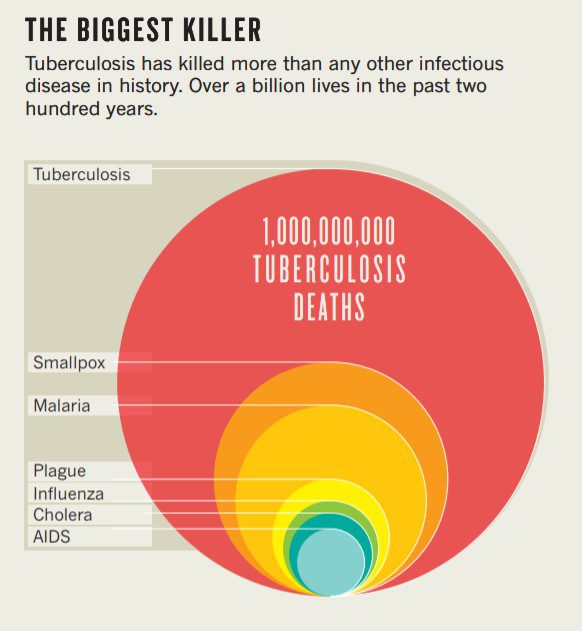Estimated reading time: 7 minutes
The advances in medicine and technology have helped curb the spread of one of the biggest global killers – infectious diseases.
By Madison Moulton
Throughout history, infectious diseases have moved through societies, killing large percentages of populations over hundreds of years. Some estimates say one infectious disease is potentially responsible for the deaths of over 1 billion people.
We have gained a better understanding of these diseases and, in some cases, limited their spread. However, there are many that remain with us today, continuing to add to their massive death tolls. These are some of the deadliest infectious diseases in history:
Influenza

Influenza is one of the most common infectious diseases worldwide, so much so that it has its own nickname – the flu. Seasonal influenza affects millions of people and results in approximately 400 000 deaths every year.
As most cases are not serious and many people have formed some kind of limited immunity to the infection, it’s easy to forget how dangerous influenza can truly be. One of the deadliest pandemics in history – the Spanish influenza outbreak of 1918 – killed an estimated 50 million people, with some believing that number is closer to 100 million. Swine flu and flu have also claimed many lives in recent history.
Influenza first received its name in 1357 in Italy. An epidemic sweeping the country was named influenza di freddo after its perceived association with the cold. But the disease is likely far older than this instance. Although difficult for historians to verify, Hippocrates may have penned one of the first descriptions of an influenza outbreak around 400BCE.
Greater knowledge of influenza and the development of a vaccine after the Spanish flu outbreak has somewhat lessened the spread of seasonal variants. However, as it continues to rapidly evolve in humans and animals every year, influenza will remain one of the deadliest diseases in history for years to come.
Plague
On par with the death toll of the Spanish flu is the Black Death of the 14th century, arguably the most well-known pandemic in history. The pandemic was caused by the bubonic plague, a lethal infectious disease that killed up to 60% of those who contract it.
Although the Black Death is the most cited plague pandemic, there were many more deadly outbreaks throughout history. One of the first documented outbreaks is known as the Plague of Justinian, beginning in 541 A.D. This plague is estimated to have caused the demise of 40% of the population of Constantinople at the time, and approximately 25 million deaths overall. The disease emerged again many times over the centuries – in Italy, London, and Marseilles – but the most recent outbreak is known as the ‘Third Pandemic’. Beginning in 1855 in China, this plague pandemic spread worldwide and took 15 million lives.

Fortunately, experts say outbreaks of this magnitude are no longer a threat. The disease has not been eradicated, and there are still a few thousand recorded cases each year, but our understanding of the bacteria Yersinia pestis has allowed us to control it effectively. Knowledge of the modes of transmission has limited the spread of the plague and any recorded cases are treated with antibiotics, reducing the death rate to around 11%.
Malaria
Malaria is one of the leading causes of death in many tropical and sub-tropical countries. Around half the world’s population live in malaria zones.
The examination of the teeth and bones of the Romans by archaeologists has provided evidence that the mosquito-borne fever once thrived in the warm, marshy river valleys of the Tiber and the Po in the Roman empire. The disease enfeebled the mightiest army of the ancient world directly through epidemics and indirectly by reducing the productivity in the agricultural sector, hastening the fall of Rome.
Malaria parasites were first found in a preserved mosquito from approximately 30 million years ago, but significant evidence in humans dates back to around 10 000 years ago. It is believed to have affected communities in ancient Greece, Rome, and China, spreading across the world and causing millions of deaths.

Today, the impacts of malaria are less severe thanks to treatment and control measures. Antimalarial medicines and insecticides have helped lower the death toll in comparison to previous centuries. However, as the infection is spread by mosquitos, it is difficult to combat completely without measures of insect population control. Fortunately, the control measures have dropped the death toll from the millions per year to a few hundred thousand.
Smallpox
Smallpox stands out on the list of deadliest diseases as the only one to be declared completely eradicated in 1980. It was caused by the variola virus, which still exists today in controlled laboratories, and had a dangerously high death rate of 30%.

Prior to its eradication, smallpox had a massive impact globally. It is believed to have caused 500 million deaths in the 20th century, and potentially far more than influenza and the plague overall. As with most infectious diseases, its origin is disputed, but evidence of smallpox rashes found on Egyptian mummies dates back at least 3000 years. Outbreaks were rampant in the era of colonization, when European settlers spread the disease to North America, South America, and Australia, decimating local indigenous populations.
The first vaccinations began in 1796 thanks to English doctor Edward Jenner. Jenner realized that previous exposure to cowpox protected individuals from smallpox. After several experiments, he declared the success of the ‘Vaccine Inoculation’ method which was adopted in the 19th century. However, the disease was only completed eradicated after a massive global vaccination effort that began in 1967. Janet Parker, a medical photographer, was the last to die from the disease in 1978.
Tuberculosis
The death tolls of influenza, plague, and smallpox pale in comparison to that of a disease still incredibly prevalent today – tuberculosis. This infectious disease, also known as TB, is said to infect approximately one-third of the global population. Although the bacteria often remain dormant, they can reactivate in small groups of people and spread to others.
Research shows the potential death toll of tuberculosis is over 1 billion in the past 200 years. But the bacteria Mycobacterium tuberculosis has been around far longer than that – several thousands of years. It is believed to have been present in human populations around 6 000 years ago. Its dormant prevalence among populations and the incredibly high fatality rate of 70% if left untreated has led some experts to declare it the deadliest disease of all time.

The infection rate and death toll have been steadily declining over the past century. This is thanks to the development of a treatment and a vaccine that is slowly lessening the spread of the infection. However, it is nowhere near eradiation. The treatment is complex, lasts several months, and can be ineffective if not taken correctly. The vaccine helps prevent TB in children but is thought to be less effective in adults. Millions of cases and around 2 million deaths are recorded each year. It was, and still remains, the deadliest infectious disease in history.
Here are some fascinating podcasts that discuss the history of infectious diseases.
Articles you may also like

The History of Games: Rome 2
By Fergus O’Sullivan. Here at the History Guild we like video games, especially ones with a historical setting. Of course, plenty of games marketed as historically accurate aren’t, especially to history enthusiasts. In this series, we’ll be taking a look at some of the bigger games around and seeing if they’re really as true to […]







